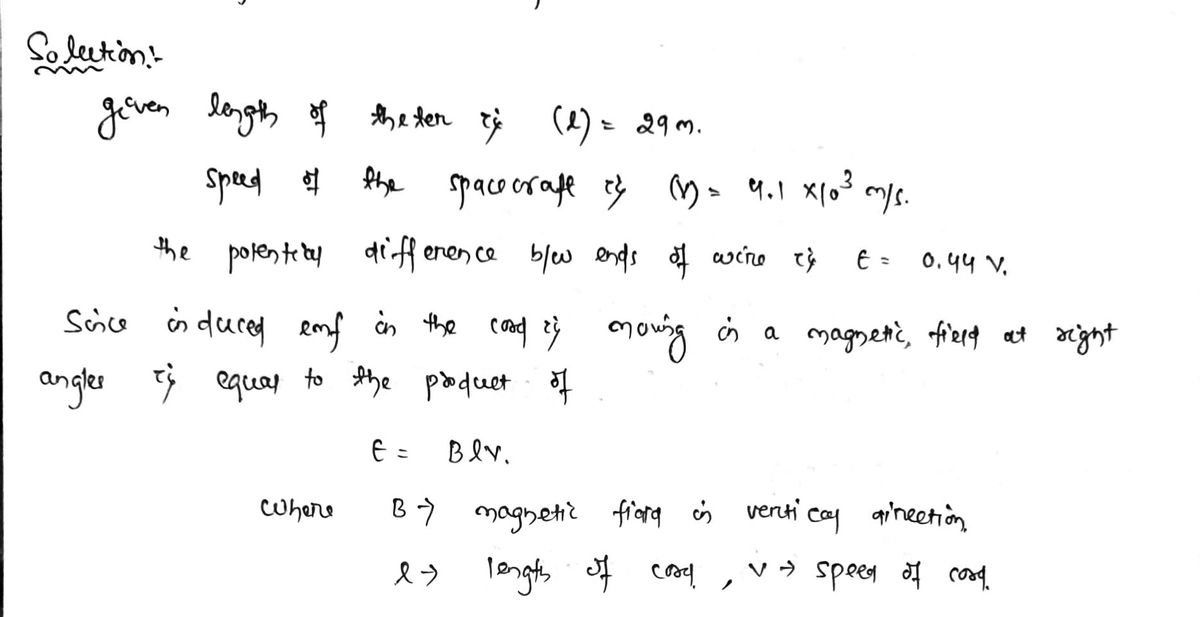Question
An astronaut is connected to her spacecraft by a 29-m-long tether cord as she and the spacecraft orbit Earth in a circular path at a speed of 4.1 103 m/s. At one instant, the voltage measured between the ends of a wire embedded in the cord is measured to be 0.44 V. Assume the long dimension of the cord is perpendicular to the vertical component of Earth's magnetic field at that instant.
(a) What is the magnitude of the vertical component of Earth's field at this location?
uT
(b) Does the measured voltage change as the system moves from one location to another? Explain.
uT
(b) Does the measured voltage change as the system moves from one location to another? Explain.
Expert Solution
arrow_forward
Step 1

Step by stepSolved in 2 steps with 2 images

Knowledge Booster
Similar questions
- A long straight wire carries a 1.5 A current. An electron moves parallel to the wire at speed 3.1 x 104 m/s. The distance between the electron and the wire is 8 cm. Calculate the magnitude of the magnetic force on the electron.(Give your answer in newtons but don't include the units.)arrow_forwardA proton is accelerated in a particle accelerator from rest through a potential difference of 0.130 kV. If the proton then passes through a uniform magnetic field of magnitude 0.120 T that is perpendicular to the proton's path, what is the radius of the path that the proton will take through the magnetic field? Give your answer in cm. (The mass of a proton is 1.672*10^-27 kg.)arrow_forwardTwo isotopes of carbon, carbon-12 and carbon-13, have masses of 19.93 × 10-27 kg and 21.59 × 10-27 kg, respectively. These two isotopes are singly ionized (+e) and each is given a speed of 5.619 x 105 m/s. The ions then enter the bending region of a mass spectrometer where the magnetic field is 0.6961 T. Determine the spatial separation between the two isotopes after they have traveled through a half-circle. Use 1.602 × 10-19 C as the elementary charge and give your answer to four significant figures. B (out of screen) Number i 0.00821 Units marrow_forward
- An electron moves in a circular path with a speed of 1.49 x 10' m/s in the presence of a uniform magnetic field with a magnitude of 2.12 mT. The electron's path is perpendicular to the field. (a) What is the radius (in cm) of the circular path? cm (b) How long (in s) does it take the electron to complete one revolution?arrow_forwardAt a certain location, Earth's magnetic field of 52 µT is horizontal and directed due north. Suppose the net field is zero exactly 8.3 cm above a long, straight, horizontal wire that carries a constant current. What are (a) the magnitude of the current and (b) the angle between the current direction and due north? (a) Number Units (b) Number Unitsarrow_forwardA long straight wire carries a 1.5 A current. An electron moves parallel to the wire at speed 3.1 x 104 m/s. The distance between the electron and the wire is 8 cm. Calculate the magnitude of the magnetic force on the electron.(Give your answer in newtons but don't include the units.)arrow_forward
- A conducting rod is positioned between two poles of a large magnet, with 26 cm of the rod within the 0.045 T magnetic field. The rod experiences a magnetic force of 1.7 × 10-3 N when 1.1 A of current passes through it. What is the angle between the rod and the magnetic field in degrees? θ = °arrow_forwardAn electron moves in a circular path with a speed of 1.41 x 10' m/s in the presence of a uniform magnetic field with a magnitude of 1.92 mT. The electron's path is perpendicular to the field. (a) What is the radius (in cm) of the circular path? cm (b) How long (in s) does it take the electron to complete one revolution?arrow_forwardDuring a transcranial magnetic stimulation (TMS) treatment, a magnetic field, typically of magnitude 5.00 T, is produced in the brain using external coils. During the treatment, the current in the coils (and hence the magnetic field in the brain) rises from zero to its peak in about 65.0 us . Assume that the magnetic field is uniform over a circular area of diameter 2.00 x 10-² m inside the brain. What is the magnitude of the average induced emf around this region of the brain during the treatment? average induced emf: Varrow_forward
- An alpha particle can be produced in certain radioactive decays of nuclei and consists of two protons and two neutrons. The particle has a charge of q = +2e and a mass of 4.00 u, where u is the atomic mass unit, with 1 u = 1.661 ✕ 10−27 kg. Suppose an alpha particle travels in a circular path of radius 4.10 cm in a uniform magnetic field with B = 1.00 T. Calculate the following values. (part 1) (a) its speed __________m/s(b) it's period of revolution _________s(c) its kinetic energy __________eV (please show units so that I can follow easier)arrow_forwardUsing an electromagnetic flowmeter, a heart surgeon monitors the flow rate of blood through an artery. Electrodes A and B make contact with the outer surface of the blood vessel, which has interior diameter 3.30 mm. For a magnetic field magnitude of 0.020 0 T, a potential difference of 110 μV appears between the electrodes. (a) Calculate the speed of the blood.arrow_forwardConsider the situation depicted below, where three closely spaced wires are carrying currents of magnitudes i = 1.2 mA, i2 = 4.1 mA and iz = 1.9 mA, with directions either into the page or out of the page, as indicated in the figure. In one of the points the magnetic field is measured to be B = (-9.2î + 4.6j) (units μΤ) In which of the points indicated in the figure was this magnetic field measured?arrow_forward
arrow_back_ios
SEE MORE QUESTIONS
arrow_forward_ios